

Tiny Green Bug May Be First Photosynthetic Animal. By Mark Brown, Wired UK Pea aphids may have an unprecedented ability to harvest sunlight, and use the energy for metabolic purposes.
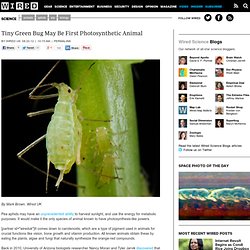
It would make it the only species of animal known to have photosynthesis-like powers. [partner id="wireduk"]It comes down to carotenoids, which are a type of pigment used in animals for crucial functions like vision, bone growth and vitamin production. All known animals obtain these by eating the plants, algae and fungi that naturally synthesize the orange-red compounds. Back in 2010, University of Arizona biologists researcher Nancy Moran and Tyler Jarvik discovered that pea aphids can make their own carotenoids, like a plant.
Entomologist Alain Robichon, of the Sophia Agrobiotech Institute in France, wanted to find out why the insects make such metabolically expensive chemicals. Carotenoids are responsible for aphid body color, and the researchers found that insects changed color depending on environmental conditions. Source: Wired.co.uk. Vascular cambium. Multiple cross sections of a stem showing vascular cambium and companion cells[1] The vascular cambium (pl. cambia or cambiums) is a lateral meristem in the vascular tissue of plants. It is a cylinder of unspecialized meristem cells that divide to give rise to cells that further divide, differentiate and specialize to form the secondary vascular tissues. Chestnut blight. The pathogenic fungus Cryphonectria parasitica (formerly Endothia parasitica) is a member of the Ascomycota (sac fungi) taxon, and is the main cause of chestnut blight, a devastating disease of the American chestnut tree that in the early 1900s caused a rapid, widespread die-off of this once plentiful tree from its historic range in the eastern United States.
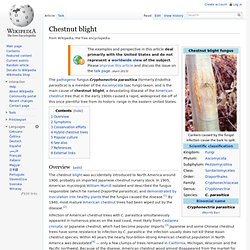
Overview[edit] The chestnut blight was accidentally introduced to North America around 1900, probably on imported Japanese chestnut nursery stock. In 1905, American mycologist William Murrill isolated and described the fungus responsible (which he named Diaporthe parasitica), and demonstrated by inoculation into healthy plants that the fungus caused the disease.[1] By 1940, most mature American chestnut trees had been wiped out by the disease.[2] It is estimated that in some places, such as the Appalachian Mountains, one in every four hardwoods was an American chestnut. A small stand of surviving American chestnuts was found in F. Food Policy Action - foodpolicyaction.org. Arbuscular mycorrhizal fungi in alleviation of salt stress: a review. AMF have been known to occur naturally in saline environments (Khan, 1974; Allen and Cunningam, 1983; Pond et al., 1984; Rozema et al., 1986; Sengupta and Chaudhuri, 1990; Carvalho et al., 2001; Hilderbrandt et al., 2001; Harisnaut et al., 2003; Yamato et al., 2008), despite the low mycorrhizal affinity of the halophytes (Brundrett, 1991).
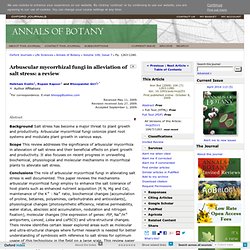
The average density of spores in saline areas is reported to be low by some researchers (Barrow et al., 1997; Carvalho et al., 2001) but not others (Khan, 1974; Bhaskaran and Selvaraj, 1997; Aliasgharzadeh et al., 2001; Landwehr et al., 2002). HSU Fall 2012 Mag - Mushrooms. THE RAIN HAD just started to clear by the time Terry Henkel and his expedition crested the 6,000-foot summit of Mt.
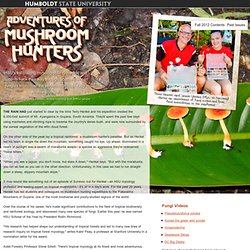
Ayanganna in Guyana, South America. They'd spent the past few days using machetes and climbing rope to traverse the country's dense bush, and were now surrounded by the surreal vegetation of the elfin cloud forest. On the other side of the peak lay a tropical rainforest: a mushroom hunter's paradise. But as Henkel led his team in single file down the mountain, something caught his eye. Up ahead, illuminated in a beam of sunlight was a swarm of marabunta wasps—a species so aggressive they're nicknamed "horse killers. " Mycelium & Econol. Investigations into an unknown organism ... [Meteorit Planet Sci. 2000.
Richard Evans Schultes. Richard Evans Schultes (SHULL-tees) was a biologist (January 12, 1915 – April 10, 2001) and may be considered the father of modern ethnobotany, for his studies of indigenous peoples' (especially the indigenous peoples of the Americas) uses of plants, including especially entheogenic or hallucinogenic plants (particularly in Mexico and the Amazon), for his lifelong collaborations with chemists, and for his charismatic influence as an educator at Harvard University on a number of students and colleagues who went on to write popular books and assume influential positions in museums, botanical gardens, and popular culture.

Gaia hypothesis. The study of planetary habitability is partly based upon extrapolation from knowledge of the Earth's conditions, as the Earth is the only planet currently known to harbour life The Gaia hypothesis, also known as Gaia theory or Gaia principle, proposes that organisms interact with their inorganic surroundings on Earth to form a self-regulating, complex system that contributes to maintaining the conditions for life on the planet.
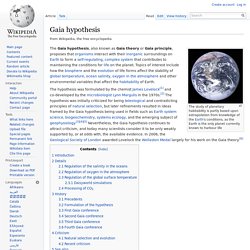
Terraforming of Mars. Artist's conception of the process of terraforming Mars.

The terraforming of Mars is the hypothetical process by which Martian climate, surface, and known properties would be deliberately changed with the goal of making large areas of the environment more hospitable to human habitation, thus making human colonization much safer and more sustainable. The concept relies on the assumption that the environment of a planet can be altered through artificial means. In addition, the feasibility of creating a planetary biosphere on Mars is undetermined. There are several proposed methods, some of which present prohibitive economic and natural resource costs, and others that may be currently technologically achievable.[1] Motivation and ethics[edit] Playlist: Thoughts on energy efficiency from the TED2013 Talent Search. Why NASA hopes Curiosity never finds water on Mars? Washington: Scientists behind Mars rover Curiosity are crossing their fingers that the rover does not discover Martian water because they fear that it may pollute the red planet.
The rover, which is looking for evidence of life on Mars, comes equipped with a drill to dig into Martian rock and hopefully unearth signs of ancient life. And what NASA fear is that microbes from Earth may still cling to the drill and could potentially survive in Martian water, thus contaminating the planet, CBS News reported. Initial plans for Mars rover Curiosity were to have all parts of the robot sterilized and sealed prior to launch to ensure that this exact scenario would not happen. Drill bits for Curiosity’s robotic arm were to be locked in a box to be opened only after the rover landed on Mars.